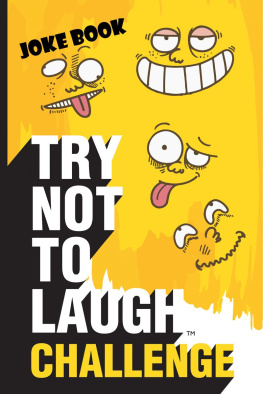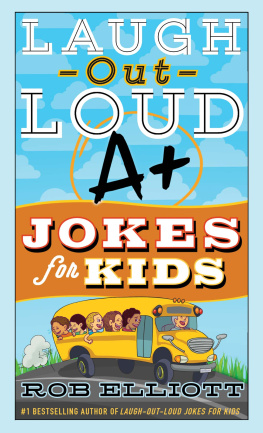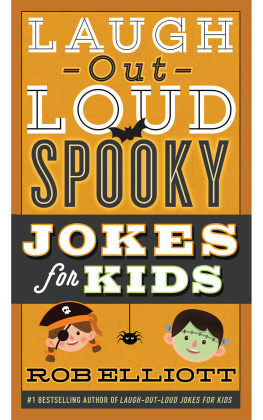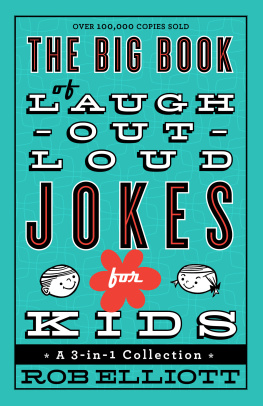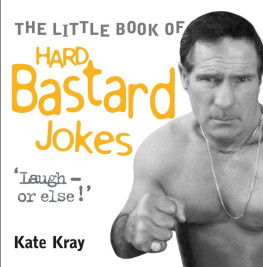INTRODUCTION:
NO LAUGHING MATTER
N o one really knows where jokes come from but we do know that they come in all shapes and sizes, and have a habit of returning just when you thought they had disappeared. Some say that there are only a dozen or so original jokes and all others are simply clever variants. I do not subscribe to this train of thought and believe human creativity extends a hell of a lot further than a bakers dozen. The same argument has been applied to traditional music, in that there are only a handful of basic tunes and all others are but variations. This is insensitive nonsense aimed at undervaluing traditional creativity and, more importantly, it doesnt stand the test of time. Traditional tunes are like pearls that have been honed in their shells with every new wave adding more polish to the gem. The same process applies to stories and, to some extent, jokes, in that they are continually changing depending on the whim and will of the person currently minding that story.
I attempt to explain in my Classic Bush Yarns (HarperCollins, 2001) how the joke, or, in that particular case, the Australian tall story, was created and passed on in the tradition. I also suggested that because of the dramatic ways we have changed our entertainment patternsbeing entertained rather than actually entertaining each otherthe role of the joke-teller has changed. This book clearly shows how contemporary entertainment continues to change rapidly and especially the dominating role of the electronic media and the World Wide Web in particular.
The Internet has come to the forefront in disseminating jokes. We still tell jokes across the dinner table and at the club and pub but it is obvious from this recent study that the Internet has emerged as a major, if not the major, distribution vehicle. I would suggest that because e-mail now plays such an accepted and widespread role in most Australian offices, it stands to reason that it would also be used for non-office work, including entertainment. I also believe, because of the growing number of people working from home offices, the art of e-mail conversation has become an important diversion. Jokes are passed on via e-mails in a conversational style reminiscent of the idle chatter one would find in the office coffee room.
There is also the growing army of recreational computer users, primarily younger and older people, who use the Internet as a means of communication between friends and for basic entertainment. It has been particularly interesting to see the large number of elderly Australians who are now wired and see the passing on of humour as part of their daily routine.
Certain demographics prefer circulating jokes that are relevant to their circle of e-mail friendstheir e-mail address lists. Young people prefer mobile text messages as a means of communication, probably viewing e-mails as too laborious and serious, and, as we know, they invent their own text languages in order to make these communications more personal. Teenagers, the high-tech generation, usually send a wide range of e-mails including humour related to their tribes (surfer, skateboard, sport, music, school gang etc), and material related to youth popular culture, especially popular gossip snippets about celebrities. Once in the serious workforce, and especially work entailing access to computers, and if they can get around company-enforced use of computer regulations, this group appears to send millions of jokes on a daily basis. Their choice of humour is wide but certain subjects dominate; in particular, sport, sex, work, transport and, once again, celebrity gossip. Middle-aged folk seem to delight in humour about marriage, sex, children, dogs, sport and divorce. Older people, not surprisingly, send each other humour about aging, dealing with technology, sex, or lack of it, and death.
Without a doubt it is the office environment where the bulk of e-mail jokes originate. Remember when the folk circulated jokes on printed sheets? Many of these were work subject related and dealt with stress, sex and office management, and, as often as not, they would depict a worker in some unfathomable dilemma. They were usually funny and aimed at getting a shared laugh from the casual passer-by. They were small posters and stuck to walls, doors and filing cabinets. Sometimes they would mysteriously appear on the office notice board explaining new office regulations or 10 reasons why the boss is a bastard. Folklorists called these photocopy lore, and true to folklores here today gone tomorrow spirit, they seem to have almost disappeared, to be replaced by the same cartoons, sets of rules etc arriving on desks via the small screen. The beauty of e-mail is that it can blast the folklore to many screens in one push of the send key. Instant folklore!
The real wonder of the Internet is that it not only zips all around the office but it can also instantly send the message all over the country and all over the world. The jokes coming out of the September 11th 2001 terrorist attacks on America certainly showed the relevance and vitality of net transmission, arriving on Australian desks at the very same time as American desks. This particular collection of jokes started life the week after the attack on the Twin Towers and has provided a five-year survey of e-mail humour distribution. Obviously I had thousands of jokes to study and also the restriction of having to select a representative and entertaining collection. I then had to consider the restrictions of subject categories such as politics, travel, marriage etc in which to represent the jokes without becoming too bogged down in semantics. Above all, I hope to provide a good belly laugh and to show evidence of a particular Australian sense of humour. I have provided a short introduction to each sectionso as to set the scene.
Folklore is a confusing word that carries a considerable amount of baggage. At the same time it has become an increasingly important tool in tracking our cultural roots, and especially how we cope with these stressful times. In a nutshell it is the lore we unconsciously create or pass on to our family and associated communities to distinguish ourselves as a people. We use folklore as an important part of our lives, passing on, among other things, traditional wisdom, values, custom, family history and, of course, humour. E-mail jokes are a very active part of the folklore process, usually being anonymous in origin and circulated in the same way we traditionally passed on spoken yarns. Many of the jokes are sent under the familiar guise of this is true and happened to a friend of a friend.
Pundits now preach that we are rapidly headed for a global world where we have one currency, one language and one government. One assumes that they would also like to add the words one culture to that scary list. Some say globalisation is tantamount to treason; however, the fact remains that we havent been able to make the present systems work effectively and the world continues to sit under the gloomy clouds of terrorism, local war, poverty, greed, racial inequality and religious fanaticism. Because our lives have become so fractured we need to look at folklore to provide us with keys to some of the puzzles we face. Humour is an important tool in relieving our communal attitude to stressful situations and bad times.
One of the main showcase arguments of the global community is the promotion of world culture, and in many ways this has created an economic dilemma. When one considers the massive investments the popular culture machines of Hollywood, New York and London now make in their supposed blockbuster films, hit recordings and mass-marketed books, it is obvious that they need larger markets than their domestic one to recoup their investment. Australia, being an English-speaking nation, is a prime target for such cultural invasion and this needs to be stacked up against our Governments rulings on such things as Australian content levels on radio, television and in publishing. Personally I dont think we have been very successful in protecting or policing our cultural content levels; however, that is another argument for another platform.



